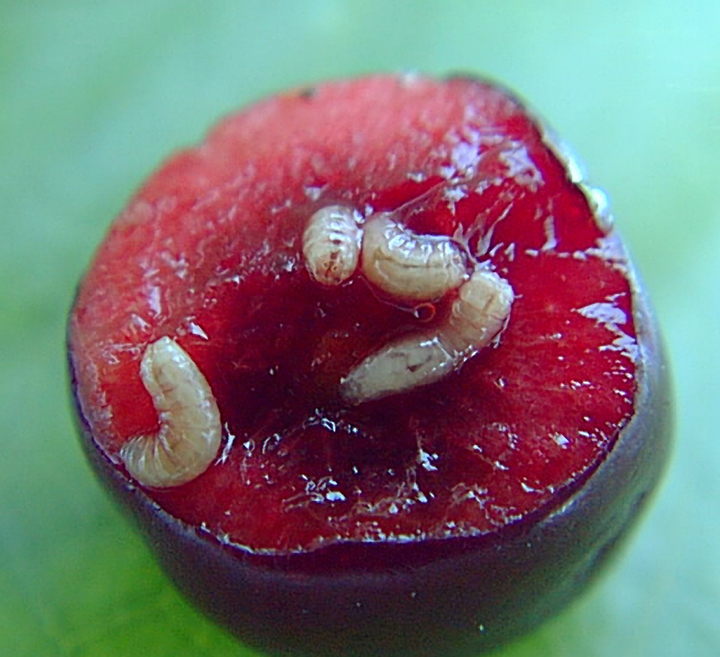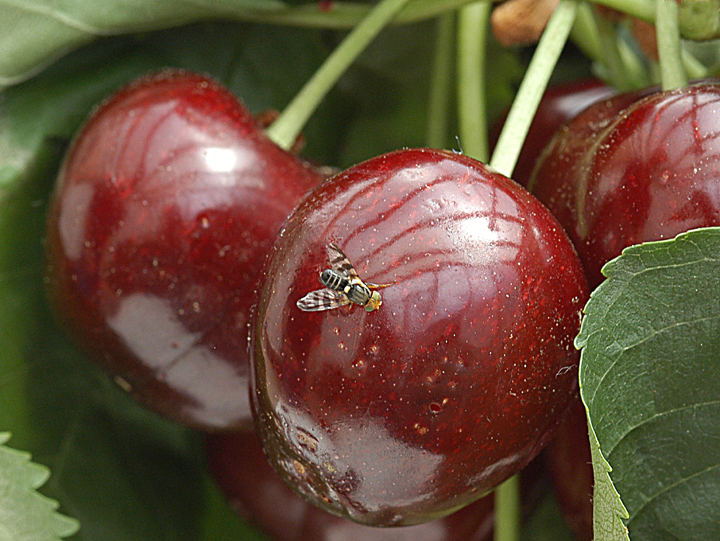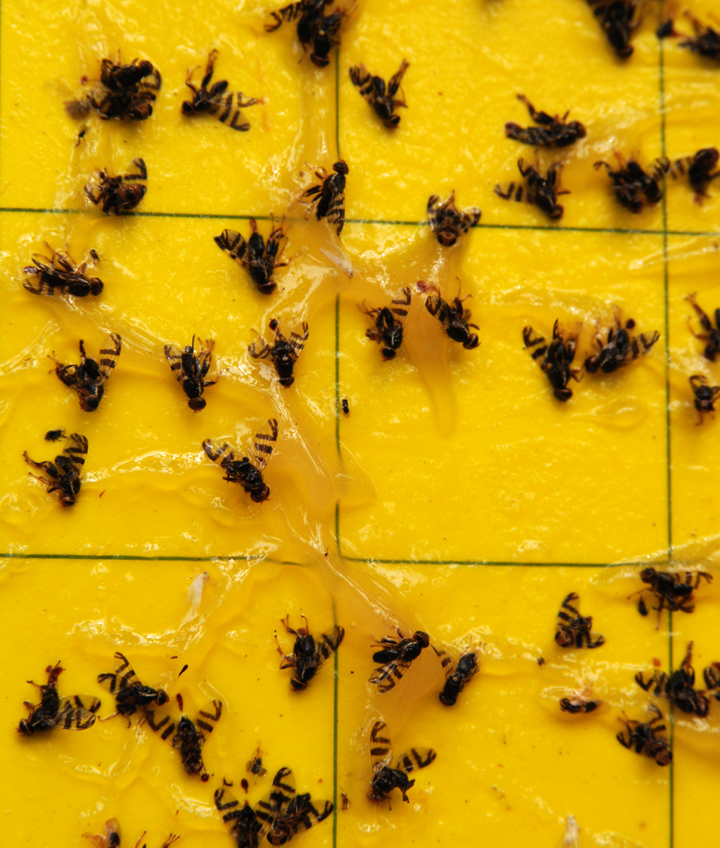by Frank J. Messina and Timothy J. Smith, originally published 1993; revised August 2010
Rhagoletis indifferens Curran (Diptera: Tephritidae)

The western cherry fruit fly is a key pest in all cherry growing regions of the western United States. It is native to North America and was reported attacking commercial cherry in the Pacific Northwest in the early 1900s. It was found in the Yakima Valley in 1942 and the Wenatchee area in 1950.
The fly’s larva develops in ripening cherries. If uncontrolled, the pest can ruin almost all the fruit on a tree. Even poor control can have serious consequences since major markets for Northwest cherries, such as California and many foreign countries, do not tolerate any infestation of packed cherries.
Adults are weak migrators and will travel no further than necessary to find a host tree. For this reason, infestations in a region tend to be spotty. However, infestations within an orchard, where the trees are close together, can spread rapidly.
Hosts
Cherry fruit fly attacks all varieties of cultivated and wild cherries.
Life stages
Egg
The egg is yellowish and elongated with a stalk at one end. It is about 1/30 inch long (0.8 mm) and is deposited under the cherry skin.
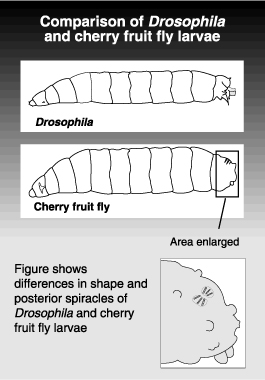 Larva
Larva
The larva is a creamy white, legless maggot, which is tapered at the head and blunt at the rear. It passes through three instars and grows to about 5/16 inch (8 mm) long. Maggots found in cherries may be those of the cherry fruit fly or could also be larvae of the family Drosophilidae. The Drosophila fruit flies do not attack fruit unless the skin has been physically damaged, allowing an opening for deposition of eggs. (NOTE: this generalization has changed with the arrival of spotted wing drosophila, Drosophila suzukii, which CAN attack undamaged fruit before it is fully ripe.) This usually happens when cherries are cracked because of wind or rain damage or bird feeding or are decayed. Larvae of the cherry fruit fly, and other Rhagoletis species, can be distinguished from the Drosophila species by examining the posterior end of the larvae. The posterior end of the cherry fruit fly larva is rounded and the anal spiracles, which are not raised, each have three darker lines extending laterally from the mid-line. The posterior of Drosophila larva has two protuberances on which the anal spiracles are found.
Pupa
The pupa is yellowish brown to dark brown and looks like a large grain of wheat. It is about 3/16 inch (4 mm) long.
Adult
The adult has a black body with white bands on the abdomen. The wings are transparent with a distinctive dark banding pattern. It can easily be distinguished from other fruit flies by the wing pattern. The fly is about 1/5 inch (5 mm) long. The female is slightly larger than the male.
Life history
Cherry fruit fly completes only one generation a year. It overwinters as a pupa in the soil. The pupae are affected by soil temperature and do not all develop at the same rate. Adults begin to emerge in May, about 5 weeks before harvest, and are active until 3 or 4 weeks after harvest. Peak emergence often coincides with harvest.
Adults live 16 to 35 days, depending on temperatures. They feed on deposits on the leaves, such as honeydew and pollen. Adult females undergo a 7- to 10-day preoviposition period before they are sexually mature. After mating, they lay eggs under the skin of the fruit. Females frequently feed on juices exuding from the puncture made during egg laying.
Each female can lay from 50 to 200 eggs in a 3-week period. The optimum temperature for egg laying is between 75 and 85 ºF. The eggs hatch in 5 to 8 days, and the larvae burrow towards the pit of the fruit where they are unreachable by most pesticides. When fully developed, 10 to 21 days after hatching, they bore their way out of the cherries and drop to the ground. Within a few hours they burrow into the soil to pupate. The majority develop into adults the following season, though a few remain dormant for two years.
Monitoring
The western cherry fruit fly is difficult to monitor, as it is not strongly attracted to traps. The most effective trap is an adhesive covered yellow panel with an ammonium-carbonate lure. These traps should be placed in the fruiting canopy of the tree, with fruit and foliage removed from around it for 12 to 18 inches. Do not assume that because no cherry fruit flies are caught in traps the orchard is safe. Because of the profound consequences of a single infested fruit being detected, control is recommended, regardless of whether flies are trapped or not are most useful in determining when the first flies emerge in a region. For this purpose, traps are placed in trees with a history of heavy infestation. Orchardists are notified of the first catch so they can begin their control programs. The date when first flies emerge and control should begin varies from year to year by up to 4 weeks. A degree-day model is available to predict first emergence and seasonal activity.
Biological control
Parasitic wasps are reported to attack larvae of the western cherry fruit fly, but control is not significant in commercial orchards.
Management
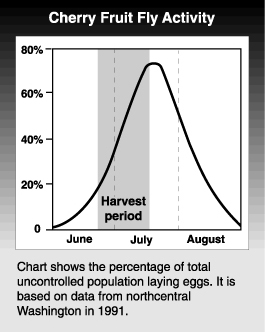 Timing of the first chemical control spray is based on the interval between emergence of the females and the first egg laying, usually 7 to 10 days. Because trapping flies in a commercial orchard is not a reliable way to determine the presence or emergence of the first fly, a degree model is helpful. This model uses a lower developmental threshold of 41 ºF, but no upper threshold. A degree-day look-up table for the western cherry fruit fly, based on daily maximum and minimum temperatures, is available. The table gives the relationship between the percentage of fly emergence and degree-days. First fly is expected at 950 degree-days after March 1. Chemical control sprays should be applied on or before 1060 degree-days to target mature, egg-laying flies. Sprays should be repeated every 10 to 21 days, depending on the residual activity of the product, to maintain residues high enough to kill adults before they lay eggs. Rain may reduce residues, requiring shorter intervals between sprays.
Timing of the first chemical control spray is based on the interval between emergence of the females and the first egg laying, usually 7 to 10 days. Because trapping flies in a commercial orchard is not a reliable way to determine the presence or emergence of the first fly, a degree model is helpful. This model uses a lower developmental threshold of 41 ºF, but no upper threshold. A degree-day look-up table for the western cherry fruit fly, based on daily maximum and minimum temperatures, is available. The table gives the relationship between the percentage of fly emergence and degree-days. First fly is expected at 950 degree-days after March 1. Chemical control sprays should be applied on or before 1060 degree-days to target mature, egg-laying flies. Sprays should be repeated every 10 to 21 days, depending on the residual activity of the product, to maintain residues high enough to kill adults before they lay eggs. Rain may reduce residues, requiring shorter intervals between sprays.
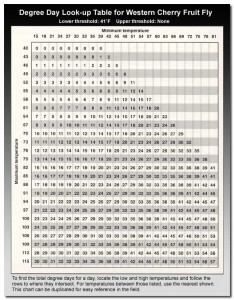 Applications of products with a very short residual life are best repeated every 7 days. Emergence and egg laying continue after harvest, making it important to maintain a control program through harvest. Most larvae found in fruit at packing houses in recent years have been very small, indicating that control programs have broken down just before harvest or during an extended harvest. Since there are always a few cherries left on the trees after harvest, a post-harvest control should be applied to prevent late emerging flies from completing their life cycles. If trees are not harvested, perhaps due to poor fruit quality, a poor market for the variety, or rain damage, they should be sprayed to prevent late season infestations and problems the following year.
Applications of products with a very short residual life are best repeated every 7 days. Emergence and egg laying continue after harvest, making it important to maintain a control program through harvest. Most larvae found in fruit at packing houses in recent years have been very small, indicating that control programs have broken down just before harvest or during an extended harvest. Since there are always a few cherries left on the trees after harvest, a post-harvest control should be applied to prevent late emerging flies from completing their life cycles. If trees are not harvested, perhaps due to poor fruit quality, a poor market for the variety, or rain damage, they should be sprayed to prevent late season infestations and problems the following year.
Western Cherry Fruit Fly Gallery
Materials available for sweet cherry
Excerpt from the WSU Crop Protection Guide. For timings at which each pesticide can be used refer to the Crop Protection Guide.

